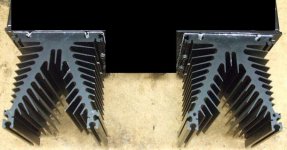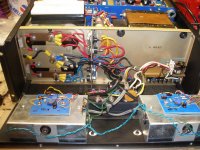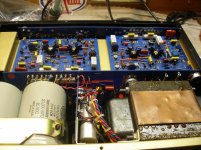Transistors are mounted on both sides. This was a stereo amp converted for high current to mono.
Thermal Resistance:0.5°C/W per each Heat sink here:
WAKEFIELD THERMAL SOLUTIONS|392-120AB|Heat Sink | Newark.com
Thermal Resistance:0.5°C/W per each Heat sink here:
WAKEFIELD THERMAL SOLUTIONS|392-120AB|Heat Sink | Newark.com
Attachments
A 2.2KVA transformer, individual high current rectifiers, lots of heavy gauge wire, 100,000uf of cap in the supply and 10 outputs for each channel.... It is the old school way of high current.
Also running it on 240Vs supply helps prevent AC line sag and then rail sag. On a 120V line it would dim the lights... 🙂
I run Ohm Fs, which are known for eating power like it's no tomorrow. They have very heavy cones that are very reactive & need lot of dampening.
jk
Also running it on 240Vs supply helps prevent AC line sag and then rail sag. On a 120V line it would dim the lights... 🙂
I run Ohm Fs, which are known for eating power like it's no tomorrow. They have very heavy cones that are very reactive & need lot of dampening.
jk
Attachments
Last edited:
My real question is this:
If I were a high end power amp designer, and wanted to account for all possibilities, how would I design the amp?
Or, to put it another way, if I were thinking outside the box, might I not invent a different way of doing it?
If I were a high end power amp designer, and wanted to account for all possibilities, how would I design the amp?
Or, to put it another way, if I were thinking outside the box, might I not invent a different way of doing it?
- Status
- Not open for further replies.


